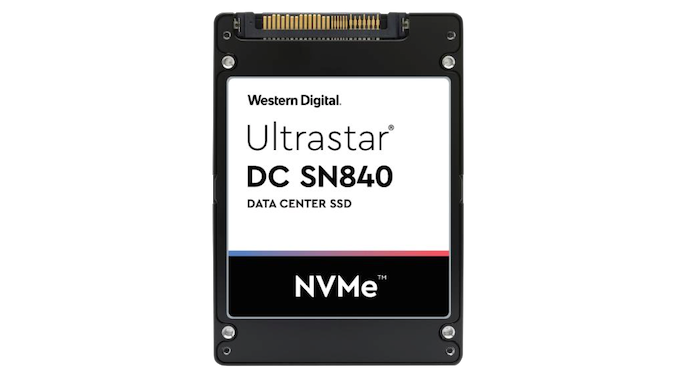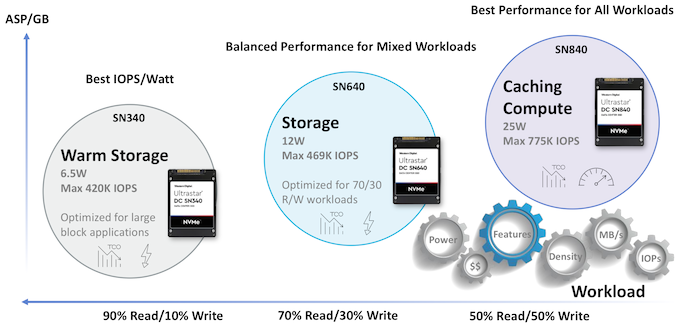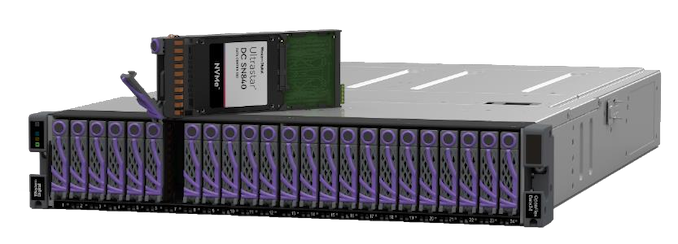Western Digital Announces Ultrastar DC SN840 Dual-Port NVMe SSD
by Billy Tallis on June 24, 2020 9:01 AM EST- Posted in
- SSDs
- Storage
- Western Digital
- Enterprise SSDs
- NVMe
- U.2
- Ultrastar

Western Digital is introducing a new high-end enterprise NVMe SSD, the Ultrastar DC SN840, and a NVMe over Fabrics 2U JBOF using up to 24 of these SSDs.
The Ultrastar DC SN840 uses the same 96L TLC and in-house SSD controller as the SN640, but the SN840 offers more features, performance and endurance to serve a higher market segment than the more mainstream SN640. The SN840 uses a 15mm thick U.2 form factor compared to 7mm U.2 (and M.2 and EDSFF options) for the SN640, which allows the SN840 to handle much higher power levels and to accommodate higher drive capacities in the U.2 form factor. The controller is still a PCIe 3 design so peak sequential read performance is barely faster than the SN640, but the rest of the performance metrics are much faster than the SN640: random reads now saturate the PCIe 3 x4 link and write performance is much higher across the board. Power consumption can reach 25W, but the SN840 provides a range of configurable power states to limit it to as little as 11W.
| Western Digital Ultrastar DC Enterprise NVMe SSD Specifications |
|||||||
| Ultrastar DC SN840 | Ultrastar DC SN640 (U.2 variant) |
Ultrastar DC SN340 | |||||
| Form Factor | 2.5" 15mm U.2 | 2.5" 7mm U.2 | 2.5" 7mm U.2 | ||||
| Interface | PCIe 3 x4 or x2+x2 dual-port |
PCIe 3 x4 | PCIe 3 x4 | ||||
| NAND Flash | Western Digital 96L BiCS4 3D TLC | ||||||
| Capacities | 1.92 TB 3.84 TB 7.68 TB 15.36 TB |
1.6 TB 3.2 TB 6.4 TB |
960 GB 1.92 TB 3.84 TB 7.68 TB |
800 GB 1.6 TB 3.2 TB 6.4 TB |
3.84 TB 7.68 TB |
||
| Write Endurance | 1 DWPD | 3 DWPD | 0.8 DWPD | 2 DWPD | 0.3 DWPD | ||
| Sequential Read | 3.3 GB/s | 3.1 GB/s | 3.1 GB/s | ||||
| Sequential Write | 3.1 GB/s | 3.2 GB/s | 2 GB/s | 1.4 GB/s | |||
| Random Read IOPS | 780k | 472k | 473k | 429k | |||
| Random Write IOPS | 160k | 257k | 65k | 116k | 7k (32kB writes) | ||
| Random 70/30 Mixed IOPS | 401k | 503k | 194k | 307k | 139k (32kB writes) | ||
| Active Power | 25 W | 12 W | 6.5 W | ||||
| Warranty | 5 years | ||||||
The SN840 supports dual-port PCIe operation for high availability, a standard feature for SAS drives but usually only found on enterprise NVMe SSDs that are top of the line or special-purpose models. Other enterprise-oriented features include optional self-encrypting drive capability and support for configuring up to 128 NVMe namespaces.
The SN840 will be available in two endurance tiers, rated for 1 drive write per day (DWPD) and 3 DWPD—fairly standard, but a step up from the 0.8 DWPD and 2 DWPD tiers offered by the SN640. The high-endurance tier will offer capacities from 1.6 TB to 6.4 TB, while the lower-endurance tier has slightly higher usable capacities at each level, and adds a 15.36 TB capacity at the top. (The SN640 is due to get a 15.36 TB option in the EDSFF form factor only.)
Between the SN840, SN640 and SN340, Western Digital's enterprise NVMe SSDs now cover a wide range of use cases, all with their latest 96L 3D TLC NAND and in-house controller designs. Shipments of the SN840 begin in July.
OpenFlex Data24 NVMe Over Fabrics JBOF
Using the new Ultrastar DC SN840 drives, Western Digital is also introducing a new product to its OpenFlex family of NVMe over Fabrics products. The OpenFlex Data24 is a fairly simple Ethernet-attached 2U JBOF enclosure supporting up to 24 SSDs (368TB total). These drives are connected through a PCIe switch fabric to up to six ports of 100Gb Ethernet, provided by RapidFlex NVMeoF controllers that were developed by recent WDC acquisition Kazan Networks. The OpenFlex Data24 is a much more standard-looking JBOF design than the existing 3U OpenFlex F3100 that packs its storage in 10 modules with a proprietary form factor; the Data24 also has a shorter depth to fit into more common rack sizes. The OpenFlex Data24 will also be slightly cheaper and much faster than their Ultrastar 2U24 SAS JBOF solution.
The OpenFlex Data24 will launch this fall.












21 Comments
View All Comments
Kakti - Thursday, June 25, 2020 - link
Edit: Really bummed out about it using PCIe 3.0 though...No way I'm dropping ~$1000 on a ultra parallel 8tb or 16tb SSD that's still on 3.0. I imagine that many chips in parallel could be pushing 7-8gb/sec if not more.back2future - Thursday, June 25, 2020 - link
one will have higher bandwidth and iops, even pcie4 on then 16 lanes, but probably (on consumer desktop mainboard) not that much capacity for that price like on above u.2 ssdshttps://www.micron.com/products/advanced-solutions... (q2/q3 2020?) is at 9GB/s read/write
back2future - Thursday, June 25, 2020 - link
and more desktop/workstation like Sabrent Rocket (~$199), Gigabyte Aorus and Corsair MP600 (pcie4 x4 lanes, 1TB, 1800TBW on 5yrs warranty (Sabrent) ~ 1 DWPD) are at 5-4.95GB/s reading and 4.4-4.25GB/s writing, with 750-600k random iops through m.2 connectorasmian - Thursday, June 25, 2020 - link
Um yeah, Sabrent Rocket... nice product (I just bought one), shame about the shoddy website experience you have to go through to register it for that 5 year warranty. Totally lets the product down.That website didn't work with my modern browser (Pale Moon), refusing to list the registration I'd just made, and was programmed so badly I managed to register the same product twice without any complaint that it was already in the database. What sort of idiots are people hiring to code their main shopfronts these days? :( I'd be less bummed about all that if the support ticket I opened to find out what had happened to my registration hadn't been closed without any explanation, and they are not replying to my emails about all this.
I hope they provide better tech support for their products than they do for their website, because that's not fit for purpose ad has killed my confidence in their brand.
back2future - Thursday, June 25, 2020 - link
You could have gone with AORUS NVMe Gen4 SSD 2TB for about $400 also, with theoretically being able getting to warranty limits by 24h*10d full speed sequential writing to disk for to reach 3600TBW (what still is 1 DWPD), Sabrent also has 2TB pcie4 nvme and even SB-RKTQ-8TB on slower pcie3 (~$1800-$1999, 4TB ~$720) and another one, Seagate Firecuda 520 2TB at 5r/4.4wrGB/s level (but 2800TBW). Corsair MP600 also a 2TB on ~$400, but some complaints with overheating while on mainboard heatsink? And also no experience with TB3 and external nvme compared to this from my side, but might be comparable to pcie3 connected from theory.back2future - Thursday, June 25, 2020 - link
While more exactly Sabrents 8TB is pcie3.1, its hard to tell where Intels Optane Alder Stream line fits into pcie4 nvme ssds, with advanced power and wear leveling management, https://wccftech.com/intel-next-generation-optane-... (table with comparing layers for 3D flash). Only Sabrent mentioning onfi4.0 support, while Gigabyte lists 2GB external DDR4. Another interesting point was that ~2026/2027 transition from hdd to flash ssd storage on servers could be done by a 90% level (https://wccftech.com/intel-next-generation-optane-... with hint to onfi4.1 with 400MT/s on page 12).back2future - Thursday, June 25, 2020 - link
Multiplexing can lift capabilities for nand data rates to 2020 spec onfi4.2 at 1600MT/s top level with onfi4.1 components used only (https://www.idt.com/us/en/about/press-room/idt-int...back2future - Thursday, June 25, 2020 - link
edit: https://www.flashmemorysummit.com/English/Collater...back2future - Thursday, June 25, 2020 - link
with OCuLink gen4 x16 16GT/s (SFF-8611) http://cdn.teledynelecroy.com/files/manuals/pciege... Thunderbolt 3 can be an alternativeTomatotech - Friday, July 3, 2020 - link
Possibly a silly question: Most modern SATA SSDs are bumping up against the 500MB/s bulk transfer limit. Could a SATA 2.5" SSD have two sata ports and be able to double data transfer that way? It could present itself to the system as a RAID0 striped array of some sort. That means the OS would understand it as being "two" SATA disks (of 0.5 size each) joined into a "single" fast volume. The OS would be able to deal with sending read and write requests through each SATA port as appropriate, just like when dealing with real dual disk RAID0.Of course, the time for this is probably long past, with the rise of m.2 NVME, but it's an interesting thought.